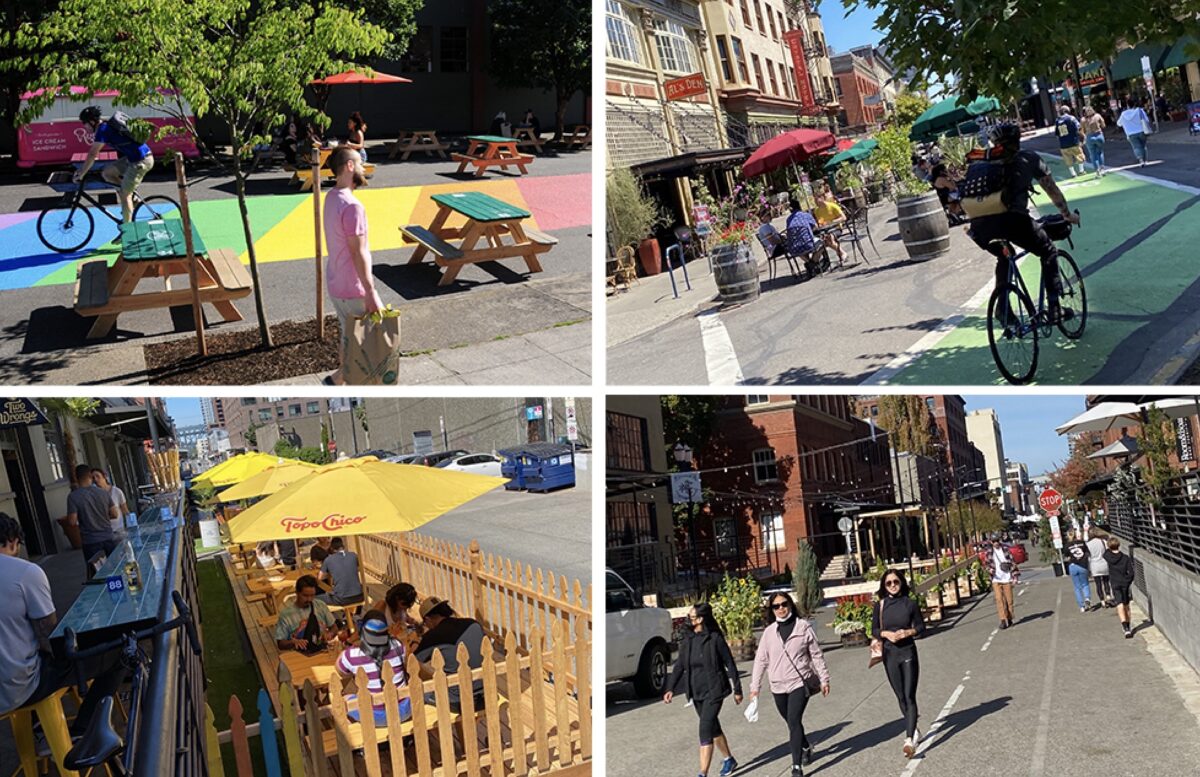
(Photos: Jonathan Maus/BikePortland)
“We’re really excited to be able to turn this into something a little more intentional and real.”
— Nick Falbo, PBOT
The proliferation of plazas and parklets in Portland since the onset of the pandemic has been nothing short of a revolution. Pre-Covid, the mere suggestion of using a few parking spots — much less an entire block — for anything other than parking cars would have been enough to spark vehement opposition. But once business owners realized they could make more money using the street to park paying customers rather than private cars, they quickly lost interest in parking advocacy.
Now with the Portland Bureau of Transportation (PBOT) committed to an expansion of the program, there appears to be no going back. What began as a temporary, stopgap measure to keep businesses afloat at the height of Covid restrictions, has quickly morphed into something much more significant that is likely to forever change our relationship with streets.
Speaking at two PBOT advisory committee meetings last month, planner Nick Falbo shared an outline of a new, federally-funded city program named Vibrant and Inclusive Community Spaces, that will institutionalize business plazas and parklets. PBOT has secured $2.5 million in federal American Rescue Plan funds to establish the program.
“Everything… we’ve done [so far] has been done kind of in a real scrappy fashion with bits and pieces over here and people working on the side. We’re really excited to be able to turn this into something a little more intentional and real in the years moving forward,” Falbo told members of the PBOT Bureau Budget Advisory Committee on October 21st.
A slide (above) shared by Falbo at the BBAC shows the agency sees these plazas as much more than places to grab drinks and dinner:
“This project and its sub-programs aim to boost business and community prosperity through reduced costs to businesses, increasing community confidence in outdoor public spaces, encouraging community participation, improving the built environment of neighborhoods, and providing places to gather and reconnect people.”
Driving this bureaucratic inertia is a simple fact: Despite their dramatic impact on our public spaces, these plazas are extremely popular and have produced almost zero controversy.
When Covid hit, PBOT rolled out the red carpet for businesses to operate in the street and handed out free permits to use public right-of-way at an unprecedented clip. Before the onset of Covid in spring 2020, PBOT had permitted just two street plazas and 10 parklets (a.k.a. parking plazas). This summer alone they handed out 88 street plaza permits (of which about 40 are active) and 401 parking plaza permits. Falbo estimates there are over 500 street dining patios currently in operation citywide.
That’s a lot of curbside space formerly used to park cars. In just one year, we’ve made more progress shifting the public perception of streets as being solely the domain of cars then we’ve made in decades of prior advocacy.
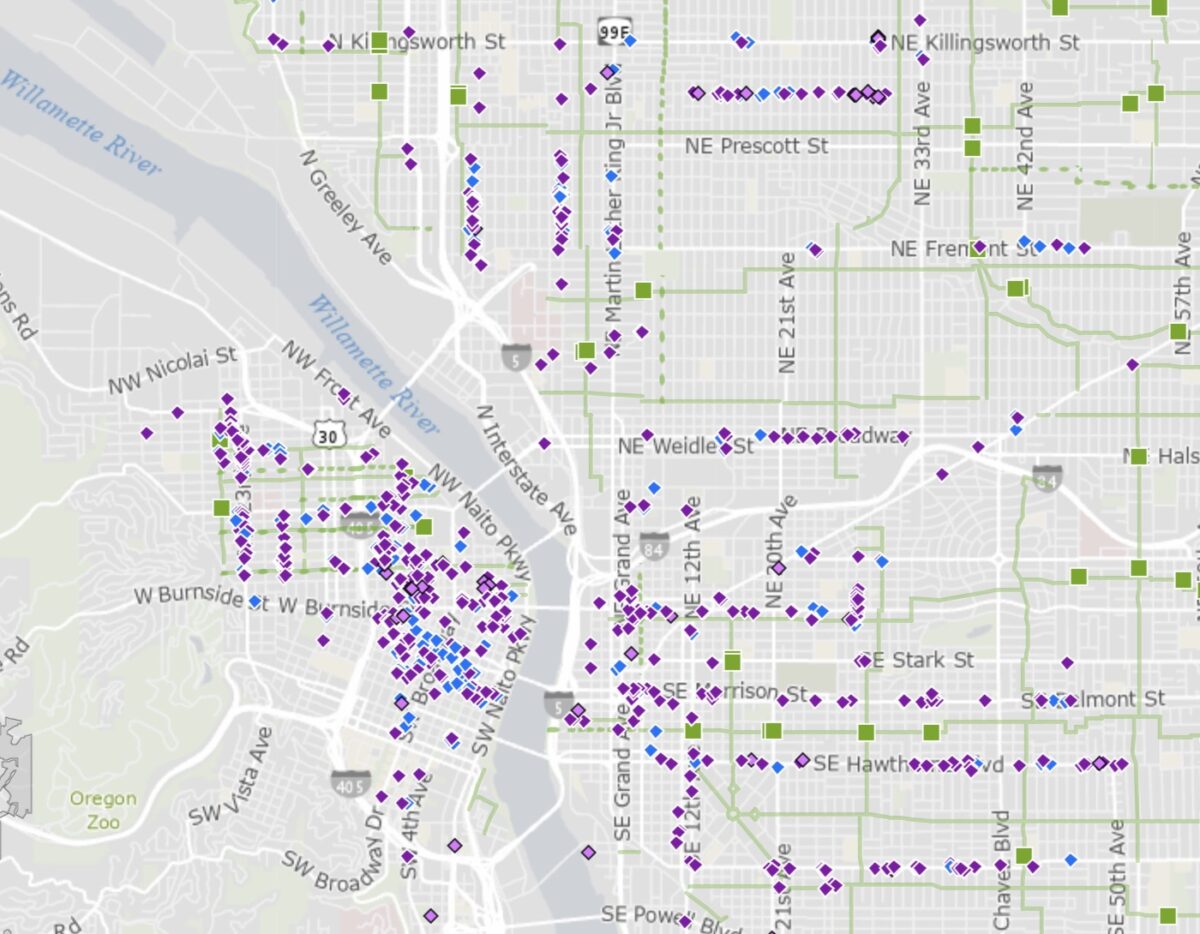
(Source: PBOT)
Nearly every commercial corridor in Portland (mostly west of 82nd) is now dotted with “street seats”, patios or some sort of carfree space. And they’re extremely popular, at least according to PBOT’s own survey data. Preliminary results of text-based surveys (promoted through pavement markings and signs at the plazas) with around 500 respondents reveal that 96% of people feel the spaces are “safe and vibrant” and 93% want them to stay in place. Another notable result of the survey is that 74% of respondents said they walked (63%) or biked (11%) to the plaza.
Advertisement
Falbo said those numbers prove there’s “explosive demand and interest” in carfree streets when PBOT makes them easy to create and accessible.
With proof of concept squarely in hand and more than a year of experience under their belt, PBOT seems eager to move into the next phase. The first phase was dictated by business owners, who were given mostly carte blanche to use the spaces however they deemed appropriate. This is why the plazas are not consistent in the way they look and feel. Some have obstructive tents and other elements that block through traffic. Some have no public seating, while others embrace passersby with trees, tables, pavement art, and other features.
At the Pedestrian Advisory Committee (PAC) meeting on October 19th, Falbo showed a slide titled, “Enhanced Plaza Upgrades” (below) that seemed to be a model of what we might expect for future plazas:
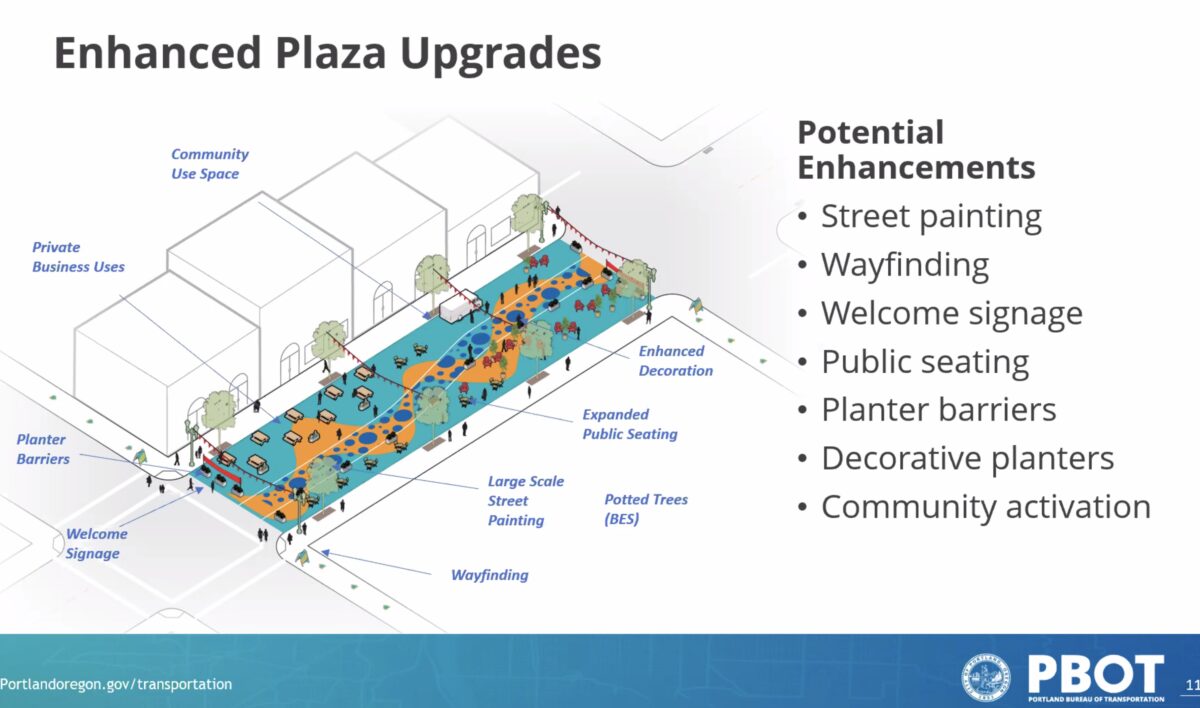
With funding in hand to beef up staff capacity and resources, the next phase will see PBOT play a much larger role. “There’s going to be work focused on active public space planning to formalize the role of these public spaces, as it relates to our transportation system plan [TSP],” Falbo said at the BBAC meeting.
“Our TSP has a lot of goals and policies about public space and street plazas, but it hasn’t really been operationalized in the same way that our bike plan or pedestrian plan has been, has so we’re excited to kind of integrate it into our planning frameworks to understand where they should be, how they support our town centers… how do we really turn this into something that can last?”
Falbo said the goal is to have PBOT building and managing the plaza spaces according to a more standardized plan, while still maintaining a strong partnership with the adjacent community.
Questions Over Who Pays, Who Benefits
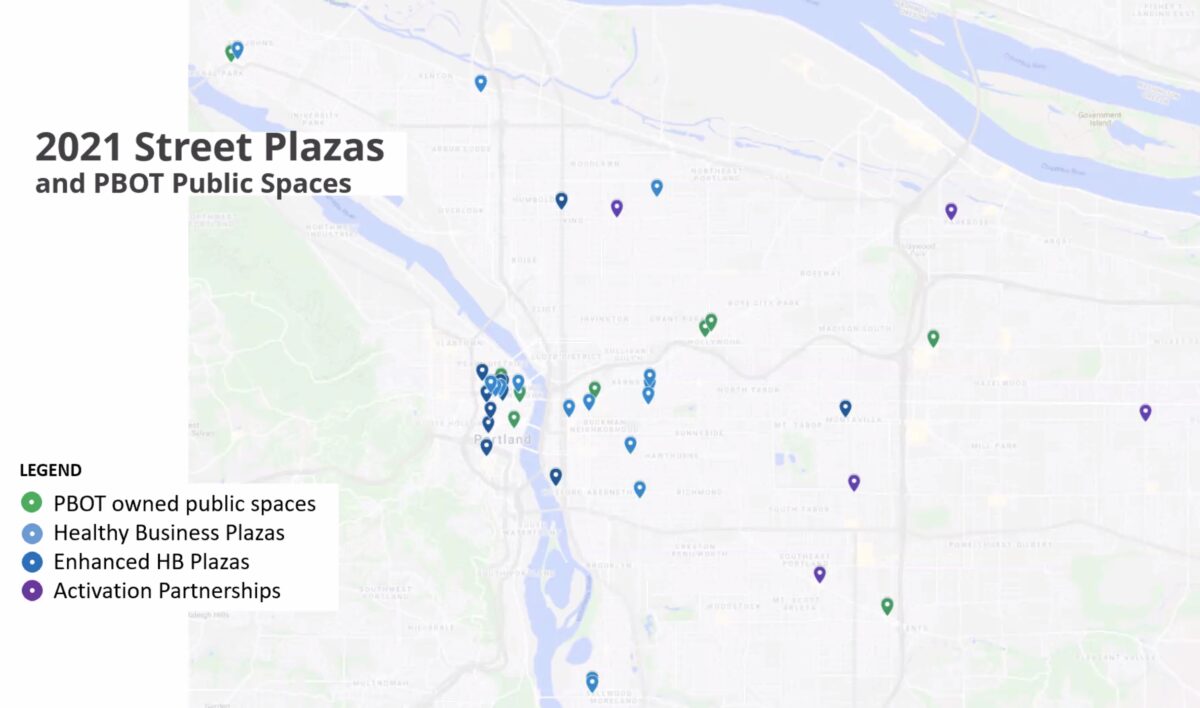
Asked by a PAC member about the dearth of plazas east of 82nd, Falbo said equity has been a key concern. “Ever since we opened up the original permitting program in 2020, where we were getting permit requests tends to align with a lot of historic development patterns.” Falbo said east Portland is a more challenging context because of the urban form that’s dominated by large arterial streets and private parking lots — the latter of which PBOT has no control over. But PBOT also had deep ties to east Portland community development groups and the new funding should help them find solutions.
Another looming issue is funding. A PBOT budget forecast estimates they’ll lose about $93 million in revenue due to the Covid pandemic — about half of that ($46.4 million) due to lost on-street parking revenue. Not only do these plazas and patios take up space that used to generate revenue for PBOT, but so far the entire Healthy Business permit program has been subsidized. “That will come due at some point,” Falbo said. PBOT says they only have funding for the plazas through July 2022.
In parking meter districts pre-Covid, PBOT charged businesses a fee to offset lost parking revenue if they wanted to use the curb zone for a different use.
For now, it’s an open question at PBOT as to how much they should charge a business for use of this valuable right-of-way. There’s an evaluation currently being done with economists to help them determine the right price. PBOT needs to be careful to balance the need for revenue with the popularity of the program. The momentum for carfree streets is worth much more to our city than the price of a permit.
If you have feedback to share about the future of plazas and parklets, email Falbo at nick.falbo@portlandoregon.gov or PBOT Safe Streets Initiative leader Scott Cohen at scott.cohen@portlandoregon.gov.





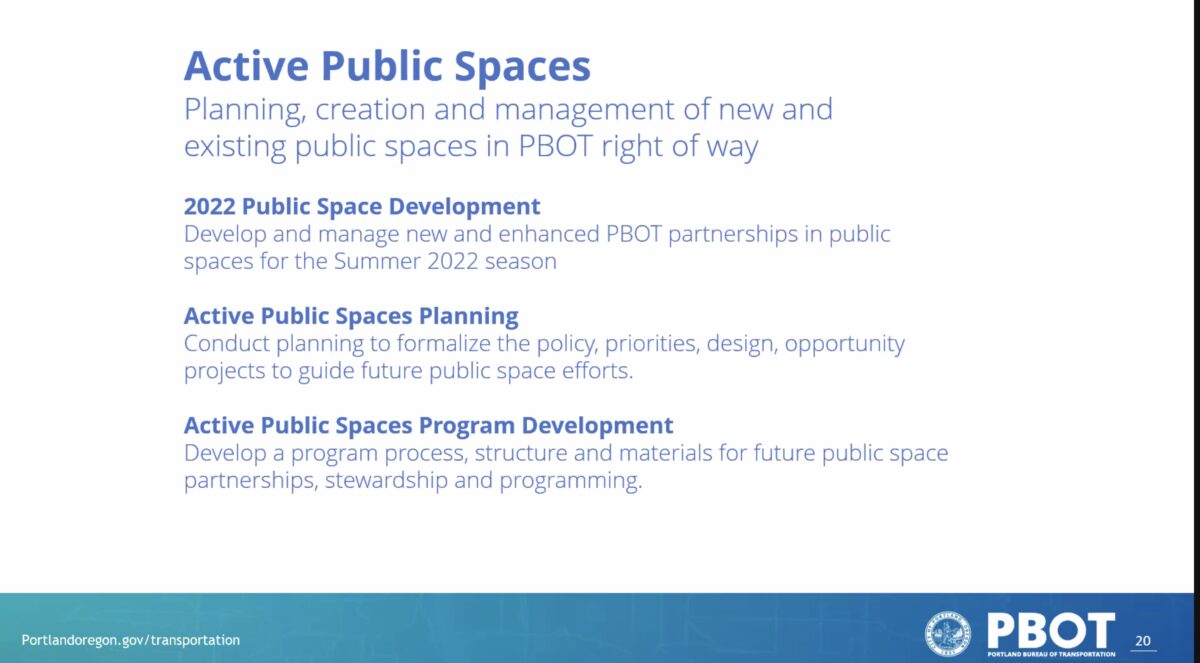

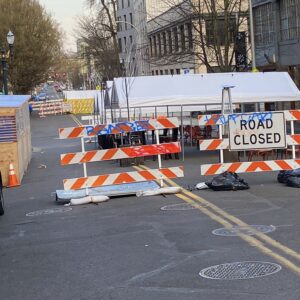

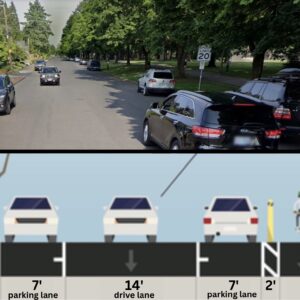
Thanks for reading.
BikePortland has served this community with independent community journalism since 2005. We rely on subscriptions from readers like you to survive. Your financial support is vital in keeping this valuable resource alive and well.
Please subscribe today to strengthen and expand our work.
Parking revenue is also why we don’t have adequate protected bike lanes. Now, street dining takes that place. Best solution from my time living elsewhere are city owned parking garages. Centralize parking for those coming to Portland from elsewhere and capitalize it. Certainly there are other models from cities that remove street parking revenue? Anyone know experts in urban planning?
Parking garages are a terrible investment. It’s almost always a better deal to re-develop a parking garage and build a hotel, residential or offices above retail instead, in the central city. That’s why food cart pods were so popular with parking lot owners: the money from renting a space to a food cart is much higher than monthly parking revenue, and it takes very little investment.
Also, the city doesn’t get property tax from property they own. If the city owns a block, it should sell it to a private buyer to be redeveloped. Then they get property tax funds every year, instead of trying to make money on parking
Sounds like they need to expand permit parking areas. Hey, I’ve got an idea: Make the entire city permitted parking and stop giving away the city’s valuable street property for free personal vehicle storage.
City owned parking storage is great for one entity. Auto drivers. Everyone else gets screwed.
I’d be interested in how the economic analysis turns out. I have to imagine that more successful businesses nets the city more tax revenue than a parking space – even when we don’t have sales tax. How much does the city make for a restaurant that employs 2-3 more people because of the extra demand and space? Probably more than a parking space. The question then is how do we channel some of that funding towards PBOT rather than the general fund?
Love the street and parking plazas. Assuming that the street plazas are car-free, is anyone else concerned about the safety of the parking plazas?!
I’m sure the good folks at PBOT have considered this, so what’s the plan on protecting citizens sitting in these ramshackle plazas – which are really fun – but not going to protect anyone from an errant vehicle. Scary as shit.
I would hope that there is consideration for enhancing safety of these parking plazas now.
It just feels like this is a case where the city might continue to wait – not be responsibly proactive – until the first catastrophe? I mean, what do the city lawyers have to say about this huge liability? Again, am I the only one who thinks many of these installations are grossly unsafe?
Businesses are gaining public space for their business use for free. Not opposed to this, but there are clearly inherent inequities – can I put a plaza in front of my toy store? It seems reasonable that a requirement of adding some protection is assumed by the business; perhaps a minimal requirement for “leading edge protection” – a super solid post or jersey barriers at the leading corner of a parking plaza, where vehicles approach. If the cost ($2,000.?) is burdensome, then the city should foot the bill and get paid back over 12 months, or some other creative arrangement.
One example of a parking plaza done right is on Belmont between 33rd and 34th aves. You’ll know it when you see it because it is defined by jersey barriers on all 3 sides in the street. This is a case where the businesses were not obligated to do this, but smart in taking care of patrons (and the general public) at great additional expense. Kudos to them!
Sure it’s a complicated and unique situation that presents such a wonderful opportunity to reimagine how streets are used; but we have to get it right. There’s got be standards and rules around safety that are being waived here, at our own peril … well, no vehicle-crash-crushes-people incidences yet, but the risk seems rather great.
I started reading tour comment and thought “that one on Belmont!” and then you nailed it! That’s the only protected parking plaza I’ve seen in town. They’re rectangular concrete barriers that are a little lower than jersey barriers but make a good bench. I’m scared to sit in most of these curbside seats, as all that separates you from speeding traffic are a few pieces of lumber. Mississippi Pizza built one years ago, but it felt safe with the slower traffic on that street. It’s way different on the side of some bigger and faster streets.
I’m all for a city approved (and subsidized?) “standardized” design that has concrete barriers facing the street. Maybe a basic footprint like the way bike corrals are, but with the option for the business to still add on and customize the space?
Comment of the week!
I lived south of Portland for 20 years, and moved to Portugal in Dec of 19 (good timing!). I was back in Portland for 3 weeks in October, and I loved the covered restaurant tables in what used to be parking spaces. It reminds me of Portugal and Spain, where one of our favorite things to do is to meet friends to eat outside and watch the world go by. Kudos to Portland for taking this step towards making quality of life more important than quality of parking.
The slide titled “Enhanced Plaza Upgrades” makes me very nervous. PBOT is horrible at these kinds of things. PBOT guidance should be limited to creating protections from vehicles, maintaining travel lanes and clearances, managing parking and drop-off zones, keeping bus routes open, and evaluating impacting to sight-lines to crosswalks and signs. PBOT has no business (and no success) trying to require/suggest/regulate welcome signs, planted barriers, potted trees, painted streets, or enhanced decoration. This looks a nightmare to me. If you doubt me, look at how PBOT co-opted and killed Parking Day. The say they are supporting it, but they are really just making sure parking is not disrupted (which is half the point) and they end up watering it down so much with rules, fees, permits, that it becomes a bland, unnoticed version of a potent, cool event.
Thanks for the great update, and excited to see continued progress on this great program!
Portland is actually lucky enough to have a long tradition of pedestrian streets in our downtown core: Halprin Sequence, PSU park blocks, Yamhill St, Ankeny Alley. As we continue to add more, some consistent elements and signage can help define this as a holistic network of ped streets that could become a new downtown attraction for visitors and locals alike!
Just like our food carts were a decade ago, Portland’s ped plazas/streets – with a signature network downtown and examples throughout our neighborhoods – could become our next showcase for how to redefine urban space in a more livable, sustainable way.
I wish they wouldn’t install these full-street plazas on established bike routes. I have to ride through the plaza on SE Ankeny and 28th a couple of times a day for my commute. They placed planters right in the middle of the through lane, which means that I have to ride within a foot or two of people, children and dogs using the dining tables. I get that they are trying to slow through traffic, but forcing riders to squeeze through like that isn’t safe either.
Really? I ride through there a lot and don’t mind it at all. I just slow down, smile at the dogs and wave to the children (or maybe it’s the reverse). It’s like 500 feet, and I’m not trying to set personal bests commuting to work…
I take it easy through there as well, but as we both know, children and pets are unpredictable. I didn’t mind it at all until they put planters directly in the middle of the path. Even moving at walking speed, I need room to maneuvre if someone steps backwards suddenly without looking.
I’ll second Mark’s comment, the plaza on Ankeny is too narrow. It feels sketchy an uncomfortable to bike through. Why not leave Ankeny alone and block off 28th?
I feel exactly the opposite. I cycle through there regularly, and really appreciate the side benefit of the plaza that it acts as a diverter for cars. The few seconds that I have to cycle a bit slower than I would otherwise are very worth having fewer cars on the greenway.
In stark contrast to the genuine diverter at 15th, the bar/beer-garden at 28th also diverts people on bikes. IMO, corporations that sell booze and unhealthy food to well off people should not have a greater right to public street space than people using active transportation.
I support an actual diverter for cars (and not bikes) on one of Portland’s most highly used cycling transportation routes.
I haven’t seen any evidence that the the plaza at 28th is stopping people on bikes from getting through (as opposed to having to just slow down temporarily); the diverter at 15th by contrast regularly sees cars driving through it.
And believe it or not, bars and restaurants are a thing that people happen to like. Selling food and drinks in the street is something that happens the world round, and the fact that its rare in the US is more of a comment of our limited thinking about what streets can be for, beyond just transportation. One of the greatest flaws in Portland’s “greenways only” strategy is that our bike network rarely interacts with destinations that people might be going to/from. It’s a real pleasure to have a commercial node on the greenway here (and at other locations such as Clinton/26th).
PBOT mustn’t set a single citywide price if it wants street plazas to flourish anywhere other than where commercial real estate is already expensive, because one-size-fits-all permit pricing would subsidize businesses in high-cost areas at the expense of businesses in low-cost areas. This is the single biggest thing they can do to give street plazas a chance throughout the city.
Street plazas in low-cost areas face an uphill battle not just because of lower density and car-centric street design, but because the cheaper commercial rent in such areas makes the economics of building street plazas there less attractive.
An idea for PBOT: where you have paid parking, set the rates dynamically, based on demand, with an aim of leaving one parking spot on each block face empty at any given time. This would end automotive circling, increase revenue, end the subsidization of property owners and businesses in the city’s most expensive areas, and reveal the true economic value of each parking spot. With this data, you could then price the street plaza permits in a data-driven manner.
When I was a wee lad, the central business district of my hometown – Canberra – was regular streets. Then in the earl-mid 1970’s the streets were closed to motorized traffic and turned into pedestrian plazas. Initially, concrete planters were used to block traffic ingress, eventually, the curb cuts were removed and the entire area is paved at the same level. I’m sure you can find a few old folks who still grumble about it, but it was a great success.
To make the Portland plazas a success, we really need to make the paved area sidewalk height, and prevent all motorized traffic from entering. I’ve only visited one off N Killingsworth, if that is a representative example, we’re talking one street of a short block between two main streets, so deliveries and mail will not be impeded by having to tote stuff half a block. The naysayers will always say nay, so we need to do what is in the best interests of Portland and Portlanders as a whole.
Super bummed they just removed the one in Montavilla on SE 79th & SE Stark. Hope it can come back in some way in the future.